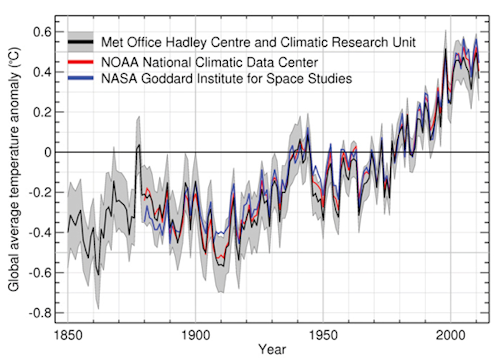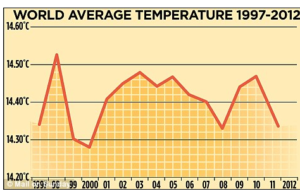by James A. Bacon
When the United Kingdom’s Met Office released its 2011 global temperature numbers back in November, the results were ambiguous enough that both the Global Warming (GW) establishment and skeptics felt vindicated. A compilation of the world’s three leading global temperature databases — the East Anglia Climate Research Unit, the NOAA Climate Data Center and the NASA Goddard Institute for Space Studies — showed that 2011 was on track to be the 11th warmest year in the past 150 years, stated the Met Office in an article headed, “Warm global temperatures continue in 2011.” Yet skeptics seized on the fact that, despite dramatic increases in greenhouse gases over the past 14 years, global temperatures have plateaued.
The GW establishment attributed the pause in rising temperatures to “a very persistent and strong La Niña, which brings cooler water to the surface of the Pacific Ocean.” When the La Niña disappears, global temperatures will resume their rise. Skeptics contend that solar activity plays a far greater role than acknowledged in mainstream climate models and that the earth could be entering a new solar cycle resembling the so-called “Maunder Minimum” that brought on the Little Ice Age.
The scientific battle lines are clearly drawn now, and we should know pretty conclusively within another decade which side is right. I am agnostic on the issue, which, I suppose makes me a closet skeptic because I don’t believe the “science is settled.” But it soon will be. Within the not-too-distant future, one of the two sets of predictions being made now should be proven conclusively wrong.
What won’t be settled, especially if the GW camp’s predictions pan out, is what to do about it. Witness a recent exchange in the letters page in the Wall Street Journal in which Kevin Trenberth and 37 other scientists responded to an op-ed previously published by 16 other scientists disputing that the evidence for global warming was “incontrovertible.” (Local angle: One of those “other” scientists was James McGrath, a world leader in polymer chemistry at Virginia Tech.)
Trenberth made an appeal to authority in support of his position that the planet “unequivocally” is getting hotter. “More than 97% of scientists actively publishing in the field agree that climate change is real and human caused,” he wrote. “It would be an act of recklessness for any political leader to disregard the weight of evidence and ignore the enormous risks that climate change clearly poses.”
He then went on to state, “In addition, there is very clear evidence that investing in the transition to a low-carbon economy will not only allow the world to avoid the worst risks of climate change, but could also drive decades of economic growth.”
Thus, Trenberth transitioned from an appeal to scientific authority to a bald assertion about the economy, which, he, as a climate scientist and not an economist, has no professional basis for making. Will a “transition to a low-carbon economy” really avoid the worst risks of climate change? Would it really drive economic growth? The point is less than incontrovertibly settled. According to today’s Wall Street Journal, the green movement is rethinking its commitment to Europe’s multibillion-dollar commitment to biofuels. In another straw in the wind, the European Commission’s energy department is reappraising its commitment to renewable energy sources in the absence of a global agreement to combat climate change. EU companies would suffer eroding international competitiveness because clean power sources are so much more expensive.
There are multiple, nested layers to the Global Warming (GW) debate, and I am not at all convinced that they lead ineluctably to Trenberth’s position in support of massive government intervention in the economy. Indeed, I suspect that the only people who are persuaded by that chain of reasoning are predisposed to be suspicious of free markets and inclined to favor big government, especially when greater government control puts like-minded people at the helm. Consider these ongoing issues:
- Can we really trust our temperature measures? Skeptics have called attention to various biases in the way temperatures are monitored, pointing to land-based measurement stations that once were located in the countryside but now, due to sprawling development, experience the urban heat-island effect. The GW establishment says it has corrected for that upward bias. For the GW orthodoxy to stand, one must agree that the statistical massaging of temperature databases adequately addresses this very real problem. (I suspect that it probably has, and I discount this as a major issue — but it is a source of contention.)
- Are today’s temperatures truly unprecedented? Skeptics contend that temperatures have undergone long-wave cycles since the end of the last Ice Age, bringing on periods of global warming during the Roman era and again during the Middle Ages. If they are correct, the current temperature peak we are experiencing could be due to factors other than rising levels of greenhouse gases, with the implication that global climate models are flawed. Using “proxy” measures such as tree ring widths, lake sediments and other natural phenomenon that vary with temperature, the GW orthodoxy downplays past warming eras and maintains that today’s temperature rise is without peer. Again, for the orthodoxy to stand, the reconstruction of past temperature peaks must be correct.
- Will greenhouse gases lead to runaway temperature increases? No one disputes the conclusion, all other things being equal, that rising levels of greenhouse gases will have a warming effect on the planet. But the GW orthodoxy goes beyond that, insisting that climatic feedback mechanisms such as increased evaporation of water into the atmosphere — water vapor is a far more potent greenhouse gas than carbon dioxide — will magnify the effect and lead to runaway temperature increases. Skeptics note that even higher CO2 levels in past climate epochs did not lead to runaway warming. Moreover, they say, crucial climate dynamics like cloud formation are still ill-understood. An increase in cloud cover would increase the earth’s reflectivity and reduce the warming sunlight penetrating the atmosphere. Skeptics claim that cloud formation is heavily influenced by varying levels of solar radiation, which interacts with the earth’s magnetosphere to block cosmic rays. The cosmic rays, it is postulated, interact with elements in the atmosphere to seed clouds. If this competing explanation is correct, the climate models underlying the GW orthodoxy need significant revision.
- Will rising temperatures be an unmitigated environmental disaster? It is not sufficient for the GW orthodoxy to maintain that temperatures are rising, it must insist that rising temperatures will lead to a string of mankind-threatening calamities from rising sea levels and stronger hurricanes to drought, starvation and conflict caused by scarce resources and the spread of environmental refugees. The potential consequences are so dire that global warming must be halted at all costs. But it strikes me that those hewing to the GW orthodoxy trumpet the downside while muting potential benefits of warming. The orthodoxy refuses to acknowledge, for instance, that increasing levels of C02 amount to atmospheric fertilizer that stimulates plant growth and increases plant resistance to drought. Some skeptics have argued that global warming would boost crop yields and promote plant life generally. While the GW priesthood worries about higher temperatures spreading malaria, no one has explored the impact of warmer weather on cold-weather diseases, such as colds and influenza. The depiction of unmitigated environmental disaster seems incredibly one-sided. Yet the view of global warming as environmental Armageddon is critical to justifying the empowerment of the state over the economy.
- Is curtailing greenhouse gases the best way to stave off the impact of global warming? Some economists have argued that the best way to adapt to runaway global warming, assuming it occurs, is to foster economic growth that will enable fragile developing nations to adapt to the postulated increase in fire, flood, disease and famine. Rich societies are more resilient than poor ones. But GW orthodoxy will not entertain that train of thought. The only proffered solution is to roll back the level of greenhouse gas emissions in the belief that (a) the global climate is amenable to such fine tuning, (b) we haven’t already passed the point of no return on irreversible climate change, and (c) there is some ideal, steady-state temperature to which we should aspire, which happens to be the point in time at which people began to get alarmed about climate change.
- Is government the best agent of change? Finally, the adherents of GW orthodoxy believe that government, in its all-knowing, far-seeing wisdom, must lead the charge. Private individuals and enterprises cannot bring about the required deep, structural changes to the economy in a timely fashion. Government must coerce, subsidize, threaten and cajole people to accelerate the shift to the low-carbon economy. In the United State, government has lavished billions of dollars upon schemes from home- conservation programs to ethanol and Renewable Portfolio Standards that require power companies to acquire an increasing share of their energy from renewable sources. The home conservation programs were a bureaucratic fiasco. Ethanol, environmentalists have now concluded, represent a step backward, and an expensive one to boot. Solar energy subsidies have brought us Solyndra, there is a growing backlash against wind power, and it is slowly sinking in that variable energy sources like wind and solar require a massive back-up of natural gas-fired generating capacity. Followers of the GW orthodoxy are sublimely confident in their ability to get things right yet they repeatedly get blind-sided by special interests and rent seekers who manipulate the subsidies, tax credits and regulations to their advantage. Tens of billions of dollars (perhaps hundreds of billions in Europe) have been largely wasted already, and the tab would run even higher if the Trenberths had their way. Ironically, if you want to see real progress in energy conservation, look to the one sphere of activity not subject to government meddling — the retrofit of commercial and industrial properties — and you’ll find dramatic progress.
To justify the current array of GW policies put into place in Europe, the U.S., Virginia and increasingly across the world requires the feat of answering “yes” to all six of the yes-no questions I have just enumerated. I am willing to trust the scientific process to sort out the first three of those sets of issues. But I’m not willing to entrust our economy to true believers attempting to implement their vision by means of a corrupted political process.
Finally, I repeat my admonition to my friends in Virginia’s environmental and smart-growth communities: Decouple your arguments for smart growth from Global Warming. If temperatures resume their upward climb in the next 10 years, the scientific debate may be settled once and you will be proven correct. On the other hand, if the orthodoxy collapses — so will a major justification for smart growth. As I hope to show in future posts, a solid case for smart growth can be built on a foundation of fiscal conservatism and repair to Virginia’s native environment.




